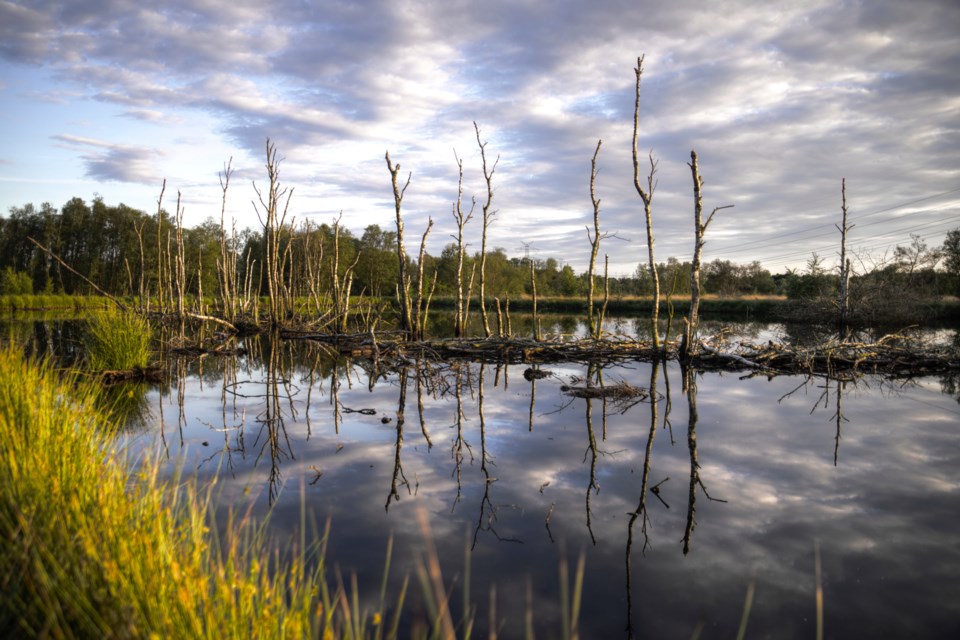In Ontario, wetlands are very important for flood control, water filtering, groundwater recharge, and discharge.
When there is a lot of rain or snowmelt, wetlands absorb and slow floodwaters, helping to alleviate property damage and can even save lives. In the face of climate change, these wetlands are ever more important as we experience more extreme storm events.
Wetlands are diverse and delicate ecosystems that provide important habitats for plants and animals. These include many familiar species, such as great blue herons, turtles, muskrats, and beavers.
Currently, Ontario’s wetlands are scored for importance through the Ontario Wetland Evaluation System. Wetlands that receive a higher score are considered provincially significant wetlands and are heavily protected. In the Nottawasaga watershed, these include the Minesing Wetlands, Osprey Wetlands, Wasaga Beach Wetland Complex, Midhurst Wetland Complex and Silver Creek Wetlands and Copeland-Craighurst-Guthrie Complex.
On Oct. 25, the Ontario government proposed changes to the Ontario Wetland Evaluation System in support of Bill 23, the More Homes Built Faster Act.
In the proposed changes, some scoring criteria have been removed from the Ontario Wetland Evaluation System, yet wetlands must still meet the same score to be considered provincially significant. This makes it much harder for wetlands to reach provincially significant wetland status, meaning many of the wetlands have the potential to be slated for development.
Many wetlands in Ontario are grouped together in complexes. This includes wetlands big and small that are less than 750 metres apart. This is important for fish and wildlife that live in wetlands, as the entire complex makes up their habitat.
The proposed legislation changes will no longer allow wetlands to be grouped together, treating each wetland as its own entity. Smaller wetlands will most likely not meet the criteria to be provincially significant, and may be open for development.
It is important for wetland evaluations to be reviewed by arm’s-length agencies with an objective view. The proposed legislation is not allowing the Ministry of Natural Resources and Forestry or conservation authorities to review wetland evaluations, leaving this responsibility to municipalities.
If municipalities are responsible for development, as well as preserving natural heritage like wetlands, where do they find the balance? Many wetlands cross municipal boundaries. How will the different municipalities determine the level of importance for the wetland?
Ontario has legislated habitat protection laws for good reason. Since the 1970s, waterfowl populations have bounced back thanks to wetland protection. Species that did not enjoy the same habitat protection, such as grassland birds, have seen a significant decline within this same time period.
Most turtles in Ontario are endangered or species of special concern, mainly due to habitat loss. Turtles rely on wetlands for food, breeding, and hibernation. By protecting wetlands, they will continue to have insects, fish and vegetation to eat, sand to lay their eggs in, and deep pools for hibernation.
Ontario’s wetlands are not only important for local animals; they support migrating birds from the entire Western Hemisphere. Many of our wetlands are resting stops for migrating birds travelling north. By allowing development in our wetlands, migrating birds will have fewer resting stops and more competition for food, which will make these long migrations even more challenging than they already are.
It takes generations for wetlands to become viable, sustainable and ecological communities. The removal of or damage to wetlands is not easily reversible, and many species may not be able to recover from this loss.
Please join conservation authorities in voicing your concerns by commenting on the Environmental Registry of Ontario by Nov. 24.
Doug Hevenor is the CAO of the Nottawasaga Valley Conservation Authority.



